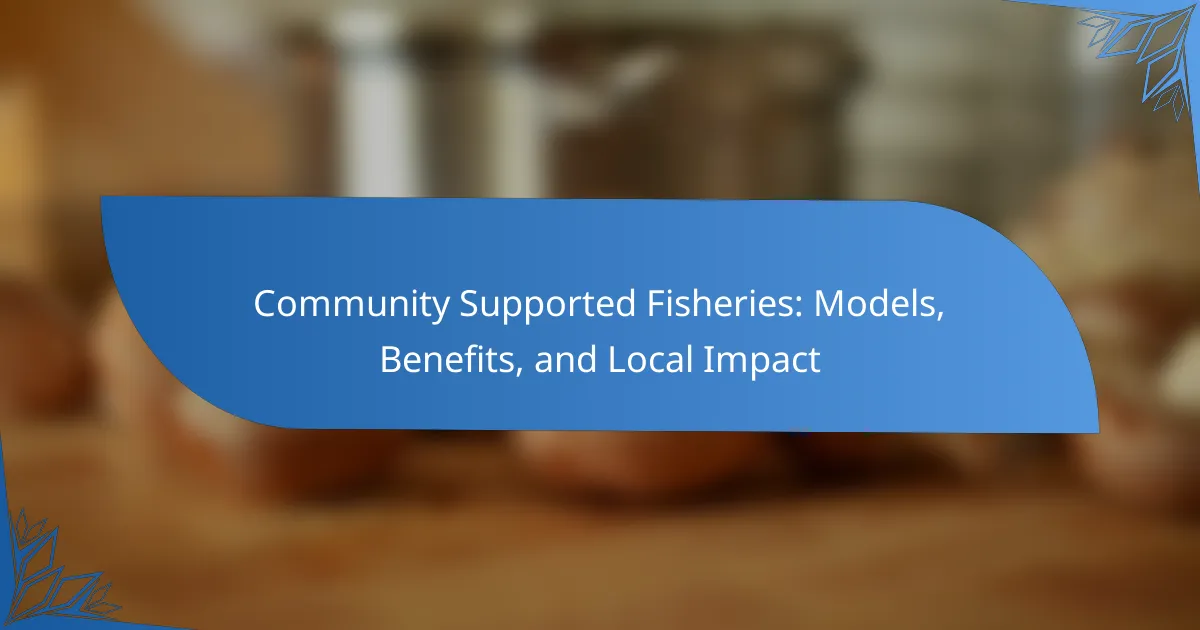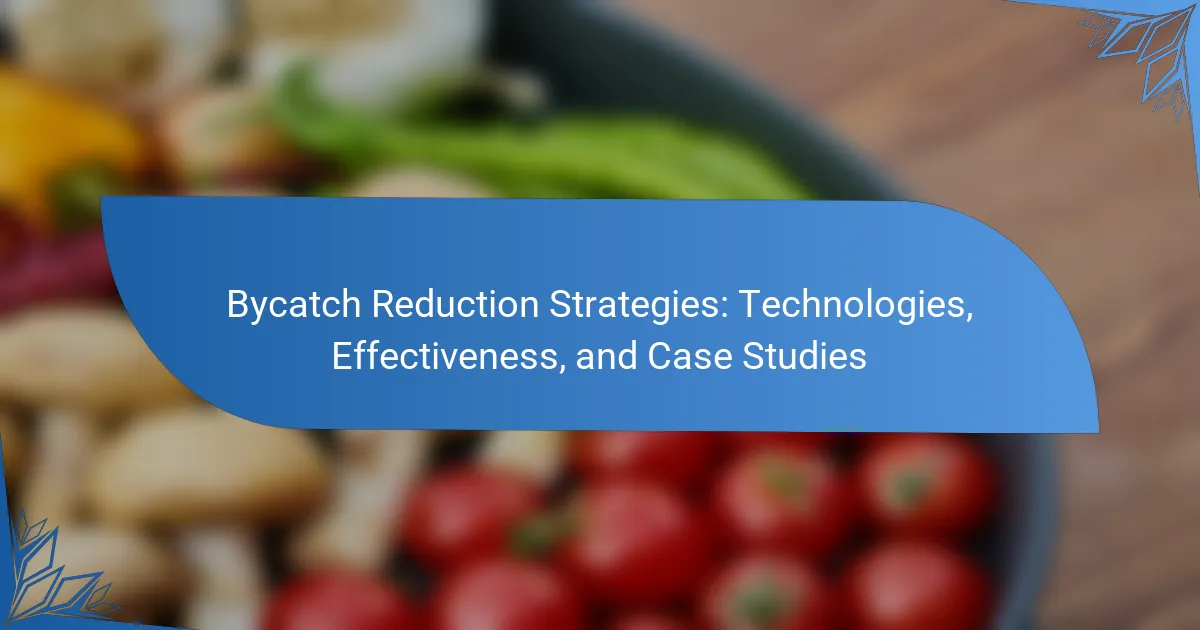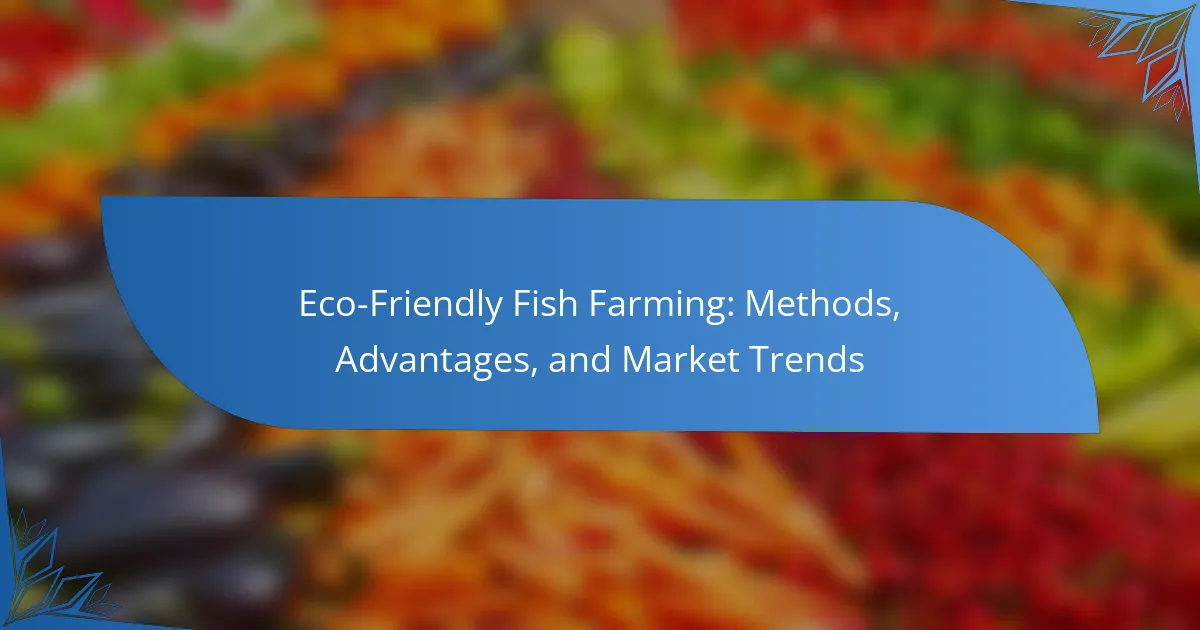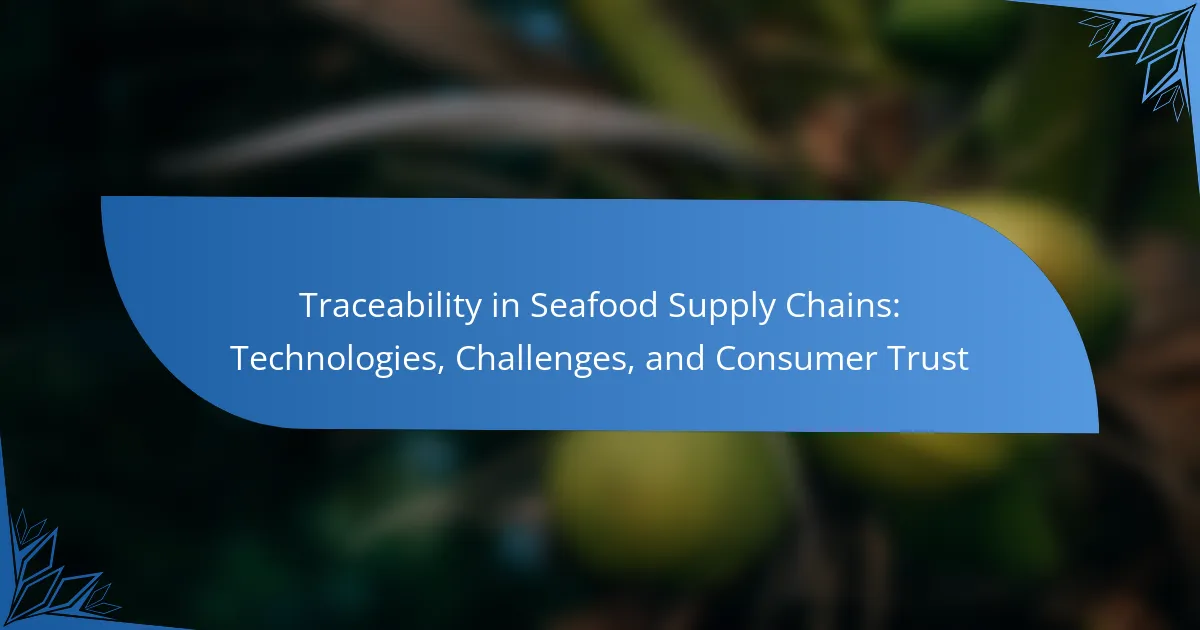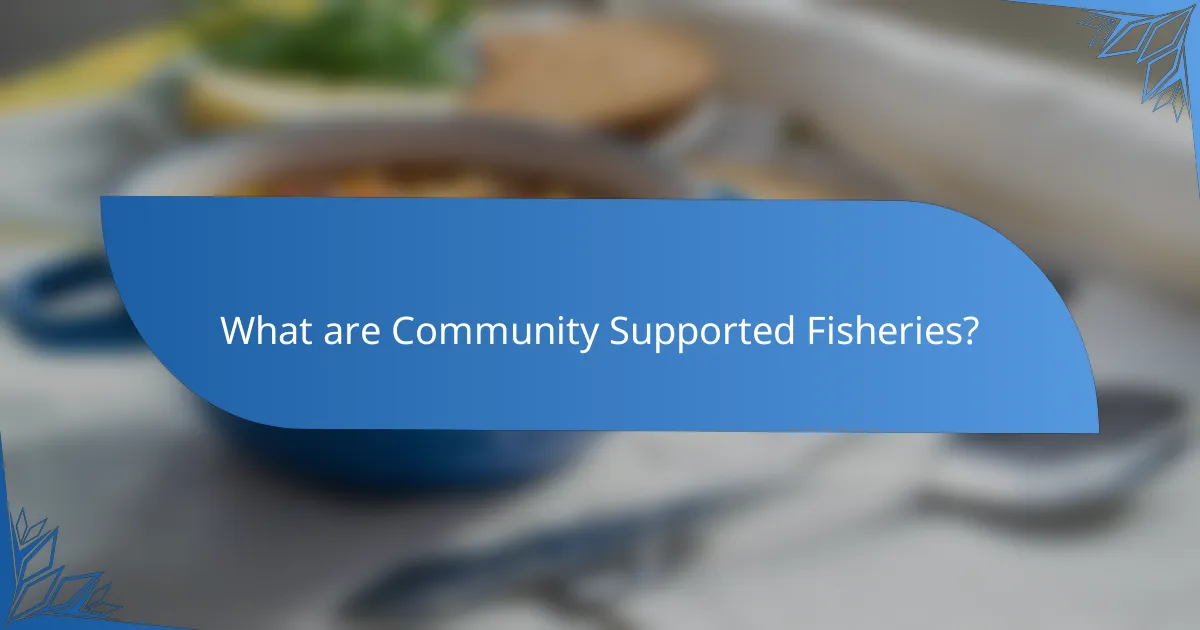
What are Community Supported Fisheries?
Community Supported Fisheries (CSFs) are direct-to-consumer seafood programs. They connect local fishers with community members who purchase shares of the catch. This model provides financial support to fishers before the fishing season starts. In return, consumers receive fresh, seasonal seafood throughout the season. CSFs promote sustainable fishing practices and local economies. They also enhance food security by offering access to fresh seafood. According to the National Oceanic and Atmospheric Administration, CSFs help reduce overfishing by supporting responsible fishing practices.
How do Community Supported Fisheries operate?
Community Supported Fisheries (CSFs) operate by establishing a direct relationship between fishers and consumers. Consumers purchase shares or subscriptions in advance, which provides financial support to local fishers. In return, consumers receive regular deliveries of fresh, locally caught seafood. This model helps to ensure sustainable fishing practices and supports local economies. CSFs often involve community engagement and education about seafood sourcing. Many CSFs also emphasize transparency in fishing practices and the quality of the catch. This approach helps to build trust between fishers and consumers. Overall, CSFs promote a sustainable food system while fostering community connections.
What are the key components of a Community Supported Fishery?
Key components of a Community Supported Fishery (CSF) include direct connections between fishers and consumers. This model allows consumers to purchase shares of the catch in advance. Shareholders receive regular deliveries of fresh seafood. The CSF promotes sustainable fishing practices. It also supports local economies by keeping profits within the community. Transparency in fishing methods and catch information is essential. Community engagement and education about seafood sustainability are vital components. These elements collectively enhance the relationship between consumers and local fishers.
How do consumers engage with Community Supported Fisheries?
Consumers engage with Community Supported Fisheries (CSFs) by purchasing shares or subscriptions. This model allows consumers to receive a regular supply of fresh seafood directly from local fishermen. Engagement typically involves selecting a share size based on family needs. Consumers often participate in community events organized by CSFs. These events may include fish tastings or educational workshops. Many consumers also provide feedback on the seafood quality and variety. This feedback helps fishermen adjust their catch based on consumer preferences. Research indicates that CSFs strengthen local economies by connecting consumers directly with fishers. This direct relationship fosters a sense of community and supports sustainable fishing practices.
What models exist within Community Supported Fisheries?
Community Supported Fisheries (CSFs) primarily operate under three models: direct sales, subscription-based, and hybrid models.
In the direct sales model, consumers purchase seafood directly from fishermen at markets or docks. This model fosters direct relationships between consumers and fishers.
The subscription-based model involves consumers paying upfront for a share of the catch over a season. This ensures financial stability for fishers and provides consumers with regular seafood deliveries.
Hybrid models combine elements of both direct sales and subscriptions. They may offer flexible purchasing options while still ensuring a consistent supply of seafood.
These models support local economies and promote sustainable fishing practices. Research shows that CSFs can increase consumer awareness about seafood sourcing and sustainability.
What are the different types of Community Supported Fisheries models?
Community Supported Fisheries (CSFs) models primarily include subscription-based, hybrid, and direct sales models. Subscription-based models involve consumers purchasing shares of the catch ahead of the fishing season. This provides fishermen with upfront capital and ensures consumers receive a regular supply of fresh seafood. Hybrid models combine subscription and direct sales, allowing consumers to buy shares while also having the option to purchase additional seafood directly. Direct sales models focus on selling seafood directly to consumers at markets or through online platforms, bypassing the subscription process altogether. Each model has unique attributes, catering to different consumer preferences and local market conditions.
How do these models vary by region or community?
Community Supported Fisheries (CSFs) vary significantly by region and community. Each community tailors its CSF model based on local fishery resources and consumer preferences. For instance, coastal communities may focus on seafood varieties abundant in their waters, while inland areas might prioritize freshwater fish. Additionally, some regions may implement subscription models, while others offer pay-as-you-go options.
Cultural factors also influence CSF practices; for example, communities with strong fishing traditions may emphasize sustainability and local heritage. In contrast, urban areas might adopt CSFs to enhance access to fresh seafood. Economic conditions shape pricing structures and membership fees, affecting participation levels.
Research shows that CSFs in New England often emphasize community engagement and education, while those in the Pacific Northwest may prioritize environmental stewardship. These regional adaptations reflect the diverse needs and values of each community, ensuring that CSFs remain relevant and effective.
What benefits do Community Supported Fisheries provide?
Community Supported Fisheries (CSFs) provide several key benefits. They promote sustainable fishing practices by connecting consumers directly with local fishermen. This model supports local economies by keeping money within the community. CSFs also provide consumers with fresh, high-quality seafood. Members often receive seasonal catches, which encourages dietary diversity. Additionally, CSFs foster a sense of community and awareness about marine ecosystems. They educate consumers about the origins of their food and the importance of sustainable practices. By reducing the distance seafood travels, CSFs also lower carbon footprints.
How do Community Supported Fisheries support local economies?
Community Supported Fisheries (CSFs) support local economies by providing direct access to fresh seafood for consumers. This model connects local fishermen with community members, fostering a sustainable food system. CSFs help ensure that a larger portion of the seafood dollar remains within the local economy. According to a report by the National Oceanic and Atmospheric Administration, CSFs can increase local fish sales by 20-30%. This economic boost supports local jobs in fishing, processing, and distribution. Additionally, CSFs promote environmentally responsible fishing practices, enhancing the long-term viability of local fisheries. By strengthening community ties and promoting local products, CSFs contribute significantly to economic resilience.
What are the environmental benefits of Community Supported Fisheries?
Community Supported Fisheries (CSFs) promote sustainable fishing practices. They help reduce overfishing by connecting consumers directly with local fishers. This model encourages the consumption of seasonal and local seafood. By prioritizing sustainable species, CSFs support marine biodiversity. They also minimize carbon footprints associated with transportation. CSFs often use environmentally friendly fishing methods. This reduces habitat destruction compared to industrial fishing. Additionally, they foster community awareness about marine ecosystems. Overall, CSFs contribute positively to ocean health and local economies.
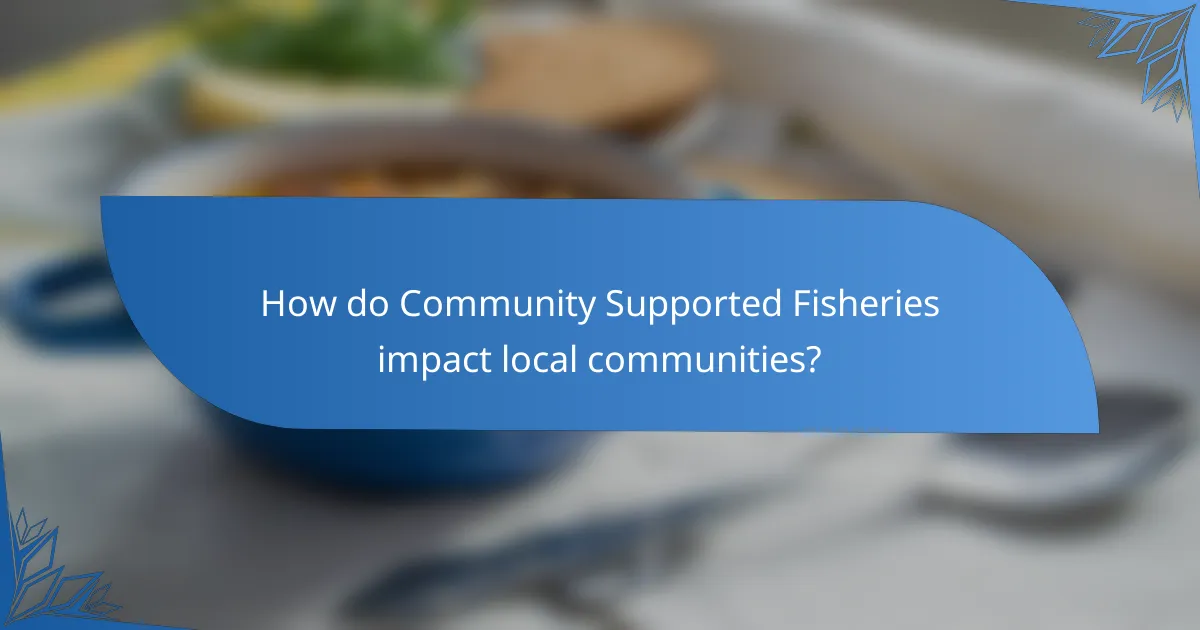
How do Community Supported Fisheries impact local communities?
Community Supported Fisheries (CSFs) positively impact local communities by fostering direct relationships between fishers and consumers. CSFs provide a sustainable source of seafood, which supports local economies. They often enhance food security by offering fresh, locally sourced fish. CSFs encourage environmentally responsible fishing practices, which helps preserve marine ecosystems. According to a study by the National Oceanic and Atmospheric Administration, CSFs can increase consumer awareness about sustainable seafood. This awareness can lead to better purchasing decisions among community members. Additionally, CSFs create jobs in fishing and related industries, boosting local employment rates. Overall, CSFs contribute to the resilience and vitality of local communities.
What role do Community Supported Fisheries play in food security?
Community Supported Fisheries (CSFs) enhance food security by providing direct access to fresh, locally sourced seafood. CSFs connect consumers with local fishermen, ensuring a stable supply of fish. This model reduces reliance on imported seafood, which can be affected by global supply chain disruptions. CSFs promote sustainable fishing practices, contributing to long-term fish populations. Studies indicate that communities with CSFs experience improved food sovereignty. By supporting local economies, CSFs strengthen community resilience against food insecurity. They also educate consumers about the importance of sustainable seafood choices. Overall, CSFs play a vital role in enhancing local food systems and promoting food security.
How do Community Supported Fisheries contribute to sustainable fishing practices?
Community Supported Fisheries (CSFs) contribute to sustainable fishing practices by promoting direct relationships between consumers and local fishermen. This model encourages responsible fishing methods that prioritize environmental health. CSFs often support seasonal and local catch, reducing overfishing and preserving fish populations. They also educate consumers about sustainable seafood choices. Research shows that CSFs can enhance local economies while maintaining ecosystem balance. According to a study by the Marine Conservation Society, CSFs help reduce carbon footprints associated with seafood transportation. This approach fosters community engagement and stewardship of marine resources. Overall, CSFs play a vital role in advancing sustainable fisheries.
In what ways do they foster community engagement and education?
Community Supported Fisheries (CSFs) foster community engagement and education through direct involvement and outreach programs. They connect local fishers with consumers, creating a sense of shared responsibility. CSFs often host workshops to educate the public about sustainable fishing practices. They provide information on the nutritional benefits of local seafood. Many CSFs engage in community events, such as seafood festivals, to promote awareness. They also offer subscription services that encourage members to learn about seasonal catches. Educational materials are frequently shared through newsletters and social media platforms. Research shows that CSFs enhance community ties and promote environmental stewardship, contributing to local economies.
How do Community Supported Fisheries influence consumer behavior?
Community Supported Fisheries (CSFs) influence consumer behavior by fostering direct relationships between consumers and local fishermen. This model encourages consumers to purchase shares of the catch, promoting a sense of community and investment in sustainable practices. CSFs often lead to increased consumer awareness about seafood sourcing and environmental impacts. Studies, such as those conducted by the Journal of Sustainable Agriculture, indicate that consumers involved in CSFs tend to prioritize sustainability and local economies. Additionally, consumers may develop a preference for seasonal and fresh seafood, altering their purchasing habits. This shift can result in greater demand for responsibly sourced fish and support for local fisheries.
What motivates consumers to participate in Community Supported Fisheries?
Consumers participate in Community Supported Fisheries (CSFs) primarily for access to fresh, local seafood. They are motivated by a desire to support local fishermen and sustainable fishing practices. Many consumers appreciate the transparency and traceability of their food sources. CSFs also provide a sense of community and connection to the source of their food. Research indicates that 70% of participants value the quality and freshness of seafood offered through CSFs. Additionally, consumers are often motivated by health benefits associated with eating fresh fish. They also enjoy the opportunity to engage in local food systems. These motivations collectively enhance consumer participation in CSFs.
How do Community Supported Fisheries affect consumer perceptions of seafood?
Community Supported Fisheries (CSFs) positively influence consumer perceptions of seafood. CSFs create a direct relationship between consumers and local fishers. This transparency fosters trust in the sourcing of seafood. Consumers perceive CSFs as a sustainable alternative to traditional seafood markets. Research shows that 70% of CSF members feel more confident in the quality of seafood they receive. Additionally, CSFs often educate consumers about sustainable fishing practices. This education reinforces positive perceptions about the environmental impact of their seafood choices. Overall, CSFs enhance consumer awareness and appreciation for local seafood.
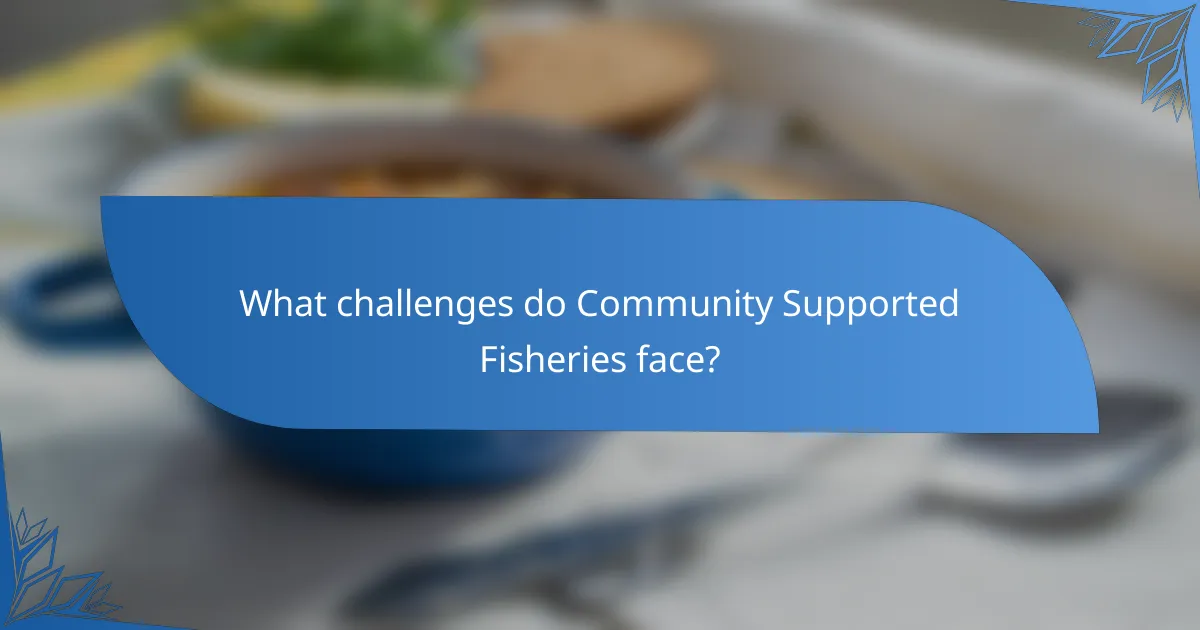
What challenges do Community Supported Fisheries face?
Community Supported Fisheries (CSFs) face several challenges. These include limited consumer awareness about CSF models. Many potential customers do not understand how CSFs operate. Additionally, CSFs often struggle with fluctuating fish populations. This variability can affect the availability of seafood. Market competition from larger seafood suppliers also poses a challenge. CSFs may find it difficult to compete on price and scale. Furthermore, logistical issues can arise in distribution and delivery. These challenges can hinder the growth and sustainability of CSFs.
What are common obstacles in establishing a Community Supported Fishery?
Common obstacles in establishing a Community Supported Fishery (CSF) include regulatory challenges, financial constraints, and community engagement issues. Regulatory challenges often arise from complex fishing laws and permits required for operation. Financial constraints can limit the ability to secure initial funding for infrastructure and operational costs. Community engagement issues may stem from a lack of awareness or interest in local seafood options. Additionally, competition from larger seafood suppliers can hinder market entry for CSFs. These obstacles can significantly impact the viability and sustainability of a CSF initiative.
How do economic factors impact the sustainability of Community Supported Fisheries?
Economic factors significantly impact the sustainability of Community Supported Fisheries (CSFs). Financial viability determines the ability of CSFs to operate and provide consistent seafood supply. Market demand influences pricing strategies and consumer participation in CSFs. A strong local economy can lead to higher membership levels and increased financial support. Conversely, economic downturns may reduce consumer spending on premium seafood options. Additionally, operational costs, such as fuel and labor, directly affect profitability. Research indicates that CSFs thrive in economically stable regions, where community investment is strong. Economic incentives, like grants or subsidies, can enhance sustainability by supporting infrastructure development.
What regulatory challenges do Community Supported Fisheries encounter?
Community Supported Fisheries (CSFs) encounter several regulatory challenges. These challenges include compliance with federal and state fishery management regulations. CSFs must navigate complex licensing requirements to operate legally. They face restrictions on catch limits and species that can be sold. Additionally, food safety regulations impose strict handling and processing standards. CSFs often struggle with zoning laws that affect where they can operate. The variability in regulations across jurisdictions can create confusion for CSF operators. Lastly, access to fishing grounds may be limited due to regulatory designations. These factors complicate the establishment and sustainability of CSFs.
What best practices can enhance the success of Community Supported Fisheries?
Engaging local communities is a best practice that enhances the success of Community Supported Fisheries (CSFs). Building strong relationships with community members fosters trust and loyalty. Regular communication about fishing practices and sustainability increases transparency. Offering diverse product options, such as fresh seafood and value-added items, attracts a wider customer base. Implementing flexible subscription models caters to varying consumer needs. Collaborating with local chefs and restaurants promotes the fishery and encourages community support. Hosting events, like community fish dinners, raises awareness and strengthens connections. Educating consumers about the benefits of supporting local fisheries boosts participation. These practices collectively contribute to the resilience and sustainability of CSFs.
How can Community Supported Fisheries improve member communication?
Community Supported Fisheries can improve member communication through regular updates and transparency. They can utilize newsletters to inform members about catch details and upcoming events. Social media platforms can facilitate real-time interaction and feedback. Hosting community meetings allows for direct engagement and discussion of concerns. Surveys can gather member preferences and suggestions. Providing educational resources enhances understanding of fishing practices and sustainability. These strategies foster a sense of community and trust among members. Effective communication leads to increased member satisfaction and retention.
What strategies help in expanding membership and community involvement?
Engaging local communities through outreach and education is essential for expanding membership in Community Supported Fisheries (CSFs). Hosting events, such as farm-to-table dinners or open houses, raises awareness and showcases the benefits of CSFs. Collaborating with local businesses can enhance visibility and attract new members. Utilizing social media platforms effectively can reach a broader audience and foster community interaction. Offering flexible membership options appeals to diverse consumer needs. Providing incentives, such as discounts for referrals or early sign-ups, encourages participation. Additionally, highlighting the sustainability and health benefits of local seafood can attract environmentally conscious consumers. According to a study by the National Oceanic and Atmospheric Administration, CSFs can significantly increase local seafood consumption and community engagement.
Community Supported Fisheries (CSFs) are direct-to-consumer seafood programs that connect local fishers with community members, allowing consumers to purchase shares of the catch in advance. The article explores various CSF models, including subscription-based, hybrid, and direct sales, while highlighting their benefits such as promoting sustainable fishing practices, supporting local economies, and enhancing food security. Key components of CSFs include transparency in fishing methods, community engagement, and education about seafood sourcing. Additionally, the article addresses challenges faced by CSFs, such as regulatory hurdles and competition, and offers best practices for enhancing their success and community involvement.
